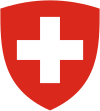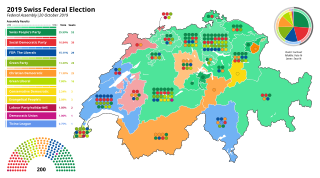
Federal elections were held in Switzerland on 25 October 1863. The Radical Left remained the largest group in the National Council, but lost its majority for the first time since 1848. [1]
| This article is part of a series on the |
 |
|---|

Federal elections were held in Switzerland on 25 October 1863. The Radical Left remained the largest group in the National Council, but lost its majority for the first time since 1848. [1]
The 128 members of the National Council were elected in 47 single- and multi-member constituencies; there was one seat for every 20,000 citizens, with seats allocated to cantons in proportion to their population. [2] As a result of the 1860 census, the number of seats was increased by eight following the previous elections in 1860, although the number of constituencies was reduced from 49; the extra seats were given to Basel-Landschaft, Basel-Stadt, Geneva, Graubünden, St. Gallen, Thurgau, Vaud and Valais. The elections were held using a three-round system; candidates had to receive a majority in the first or second round to be elected; if it went to a third round, only a plurality was required. Voters could cast as many votes as there were seats in their constituency. [2] In six cantons (Appenzell Innerrhoden, Appenzell Ausserrhoden, Glarus, Nidwalden, Obwalden and Uri), National Council members were elected by the Landsgemeinde.
Voter turnout was highest in the Canton of Schaffhausen (where voting was compulsory) at 88.2% and lowest in the Canton of Zürich at 18.6%.
 | |||||
|---|---|---|---|---|---|
| Party | Votes | % | Seats | +/– | |
| Radical Left | 44.1 | 59 | –5 | ||
| Liberal Centre | 23.8 | 37 | 0 | ||
| Catholic Right | 19.0 | 21 | +6 | ||
| Democratic Left | 6.7 | 6 | +5 | ||
| Evangelical Right | 4.6 | 5 | +2 | ||
| Independents | 1.8 | 0 | 0 | ||
| Total | 128 | +8 | |||
| Total votes | 259,398 | – | |||
| Registered voters/turnout | 556,738 | 46.59 | |||
| Source: BFS | |||||
| Constituency | Seats | Party | Seats won | Elected members | |
|---|---|---|---|---|---|
| Zürich 1 | 4 | Liberal Centre | 3 |
| |
| Evangelical Right | 1 | Paul Carl Eduard Ziegler | |||
| Zürich 2 | 3 | Liberal Centre | 3 |
| |
| Zürich 3 | 3 | Liberal Centre | 3 |
| |
| Zürich 4 | 3 | Liberal Centre | 3 |
| |
| Bern 5 | 4 | Radical Left | 4 |
| |
| Bern 6 | 4 | Evangelical Right | 2 |
| |
| Radical Left | 2 |
| |||
| Bern 7 | 4 | Radical Left | 4 |
| |
| Bern 8 | 4 | Radical Left | 4 |
| |
| Bern 9 | 3 | Radical Left | 2 |
| |
| Evangelical Right | 1 | Peter von Känel | |||
| Bern 10 | 4 | Radical Left | 4 |
| |
| Lucerne 11 | 2 | Liberal Centre | 1 | Josef Martin Knüsel | |
| Radical Left | 1 | Wilhelm Schindler | |||
| Lucerne 12 | 2 | Catholic Right | 2 |
| |
| Lucerne 13 | 3 | Radical Left | 3 |
| |
| Uri 14 | 1 | Catholic Right | 1 | Alexander Muheim | |
| Schwyz 15 | 2 | Catholic Right | 2 |
| |
| Obwalden 16 | 1 | Catholic Right | 1 | Franz Wirz | |
| Nidwalden 17 | 1 | Liberal Centre | 1 | Alois Wyrsch | |
| Glarus 18 | 2 | Liberal Centre | 2 |
| |
| Zug 19 | 1 | Liberal Centre | 1 | Wolfgang Henggeler | |
| Fribourg 20 | 3 | Catholic Right | 3 |
| |
| Fribourg 21 | 2 | Catholic Right | 2 |
| |
| Solothurn 22 | 3 | Radical Left | 2 |
| |
| Catholic Right | 1 | Franz Bünzli | |||
| Basel-Stadt 23 | 2 | Liberal Centre | 1 | Johann Jakob Stehlin | |
| Radical Left | 1 | Wilhelm Klein | |||
| Basel-Landschaft 24 | 3 | Radical Left | 3 |
| |
| Schaffhausen 25 | 2 | Liberal Centre | 1 | Friedrich Peyer im Hof | |
| Democratic Left | 1 | Wilhelm Joos | |||
| Appenzell Ausserrhoden 26 | 2 | Liberal Centre | 2 |
| |
| Appenzell Innerhoden 27 | 1 | Catholic Right | 1 | Johann Baptist Dähler | |
| St. Gallen 28 | 3 | Liberal Centre | 3 |
| |
| St. Gallen 29 | 3 | Liberal Centre | 2 |
| |
| Democratic Left | 1 | Basil Ferdinand Curti | |||
| St. Gallen 30 | 3 | Radical Left | 1 |
| |
| Democratic Left | 1 | Georg Friedrich Anderegg | |||
| Grisons 31 | 2 | Radical Left | 1 | Johann Gaudenz von Salis | |
| Liberal Centre | 1 | Simeon Bavier | |||
| Grisons 32 | 2 | Radical Left | 1 | Alois de Latour | |
| Catholic Right | 1 | Johann R. von Toggenburg | |||
| Grisons 33 | 1 | Liberal Centre | 1 | Andreas Rudolf von Planta | |
| Aargau 34 | 3 | Liberal Centre | 3 |
| |
| Aargau 35 | 4 | Liberal Centre | 2 |
| |
| Radical Left | 2 |
| |||
| Aargau 36 | 3 | Catholic Right | 2 |
| |
| Radical Left | 1 | Franz Waller | |||
| Thurgau 37 | 5 | Liberal Centre | 2 |
| |
| Catholic Right | 1 | Augustin Ramsperger | |||
| Radical Left | 1 | Johann Ludwig Sulzberger | |||
| Democratic Left | 1 | Fridolin Anderwert | |||
| Ticino 38 | 3 | Radical Left | 3 |
| |
| Ticino 39 | 3 | Radical Left | 2 |
| |
| Catholic Right | 1 | Michele Pedrazzini | |||
| Vaud 40 | 4 | Radical Left | 2 |
| |
| Liberal Centre | 1 | Édouard Dapples | |||
| Democratic Left | 1 | Jules Eytel | |||
| Vaud 41 | 4 | Liberal Centre | 2 |
| |
| Radical Left | 2 |
| |||
| Vaud 42 | 3 | Radical Left | 2 |
| |
| Democratic Left | 1 | John Berney | |||
| Valais 43 | 2 | Catholic Right | 2 |
| |
| Valais 44 | 1 | Catholic Right | 1 | Charles de Rivaz | |
| Valais 45 | 2 | Radical Left | 2 |
| |
| Neuchâtel 46 | 4 | Radical Left | 4 |
| |
| Geneva 47 | 4 | Radical Left | 4 |
| |
| Source: Gruner [3] | |||||
| Party | Seats | +/– | |
|---|---|---|---|
| Catholic Right | 17 | +4 | |
| Liberal Centre | 13 | 0 | |
| Radical Left | 9 | –4 | |
| Evangelical Right | 1 | 0 | |
| Democratic Left | 0 | 0 | |
| Independents | 4 | 0 | |
| Total | 44 | 0 | |
| Source: The Federal Assembly | |||

The Council of States is the upper house of the Federal Assembly of Switzerland, and the lower house being the National Council. It comprises 46 members.

Federal elections were held in Switzerland on 26 October 1851. The Radical Left remained the largest group in the National Council, winning 78 of the 120 seats.

Federal elections were held in Switzerland on 29 October 1854. The Radical Left remained the largest group in the National Council, winning 80 of the 120 seats.

Federal elections were held in Switzerland on 28 October 1857. The Radical Left remained the largest group in the National Council, winning 80 of the 120 seats.

Federal elections were held in Switzerland on 28 October 1860. Despite large losses, the Radical Left remained the largest group in the National Council, winning 64 of the 120 seats.

Federal elections were held in Switzerland on 28 October 1866. The Radical Left remained the largest group in the National Council.

Federal elections were held in Switzerland on 31 October 1869. The Radical Left remained the largest group in the National Council.

Federal elections were held in Switzerland on 27 October 1872. The Radical Left remained the largest group in the National Council.

Federal elections were held in Switzerland on 30 October 1881. The Radical Left remained the largest group in the National Council, regaining the majority they had lost in 1863.

Federal elections were held in Switzerland on 26 October 1884. The Radical Left retained its majority in the National Council.

Federal elections were held in Switzerland on 30 October 1887. The Radical Left narrowly retained its majority in the National Council.

Federal elections were held in Switzerland on 26 October 1890. The Radical Left narrowly retained its majority in the National Council.

Federal elections were held in Switzerland on 29 October 1893. The Radical Left narrowly retained its majority in the National Council.

Federal elections were held in Switzerland on 26 October 1899. The Free Democratic Party retained its majority in the National Council.

Federal elections were held in Switzerland on 26 October 1902. The Free Democratic Party retained its majority in the National Council.

Federal elections were held in Switzerland on 29 October 1905. The Free Democratic Party retained its majority in the National Council.

Federal elections were held in Switzerland on 29 October 1908. The Free Democratic Party retained its majority in the National Council.

Federal elections were held in Switzerland on 29 October 1911. The Free Democratic Party retained its majority in the National Council.

Federal elections were held in Switzerland on 28 October 1917. The Free Democratic Party retained its majority in the National Council. They were the last elections held under the majoritarian system; following a referendum in 1918 in which two-thirds of voters voted for the introduction of proportional representation, the electoral system was changed and early elections held in 1919.

Federal elections were held in Switzerland on 20 October 2019 to elect all members of both houses of the Federal Assembly. This was followed by the 2019 election to the Swiss Federal Council, the federal executive, by the United Federal Assembly.